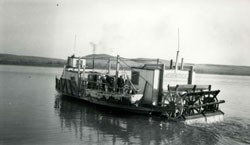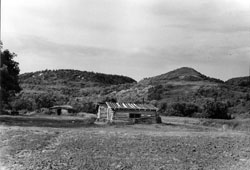We’ve launched a new web portal! Visit findhistory.nd.gov to search our collections.
Due to a road closure, the Killdeer Mountain Battlefield State Historic Site is temporarily closed.
Early (Beaver) Trade (ca. 1790 to 1830)
European fur traders reached Pembina in the late 18th century. First written records of local fur trade activities come from the journals of Charles Chaboillez who established North West Company post called Fort Pambian at the mouth of the Pembina River during the 1797-98 season. His journal noted that Hudson’s Bay Company and XY Company constructed posts nearby in the same year. He also noted a North West post on the east side of the Red (St. Vincent, Minnesota) which had been established by Peter Grant in 1794.
In 1801 Alexander Henry the Younger built a more permanent North West post on the north side of the Pembina River. He directed Red River  trapping and trading operations there until 1808. His journals provide interesting commentaries about fur trade activities and European-Indian relations.
trapping and trading operations there until 1808. His journals provide interesting commentaries about fur trade activities and European-Indian relations.
Canoes were used to transport trade goods from York Factory or Montreal to the posts. The canoes left the eastern ports in the spring, and the winter’s supply of furs was carried back in the return trip.
Trade goods and furs were packed into 90-pound bundles called “pieces.” When the canoe and cargo had to be carried from one lake or river system to another, each voyageur carried a minimum of two pieces (sometimes three or four pieces) on his back. The portage was accomplished at a brisk trot. When passengers occasionally came on a canoe trip, they too were often carried on the voyageurs’ backs so as not to slow down the expedition!
Late (Bison) Fur Trade (ca. 1830 to 1880)
In the 1840s, entrepreneur Norman Kittson established an American Fur Trade Company post at Pembina, and began serious competition against the powerful Hudson’s Bay Company monopoly. The focus of the trade became bison, rather than beaver. The area between Pembina and Fort Garry (Winnipeg) was inhabited by a large, mobile population of Métis people, descendants of fur traders and Native Americans. Twice each year the Métis met at St. Joseph (west of Pembina) and traveled as far west as necessary to find large bison herds.  The results of the hunt were bison robes and pemmican, a highly nutritious food made of dried bison meat and melted fat. These products were traded at Pembina for manufactured goods.
The results of the hunt were bison robes and pemmican, a highly nutritious food made of dried bison meat and melted fat. These products were traded at Pembina for manufactured goods.
Pembina became a gateway between Canadian fur trade operations based out of Winnipeg and St. Paul, Minnesota, which was the terminus of railroad and steamboat connections in the United States.
The bison trade lasted until the 1880s, when the herds became hunted to the point of near-extinction.
Address:
805 State Highway 59,
Pembina, ND 58271
Get Directions
Tuesday After Labor Day–Memorial Weekend Friday:
9 a.m.–5 p.m.
Tues.–Sat.
Memorial Weekend Saturday–Labor Day:
9 a.m.–5 p.m.
Daily
Contact Pembina State Museum:
phone: 701.825.6840
email: shspembina@nd.gov
Contact SHSND:
phone: 701.328.2666
email: history@nd.gov